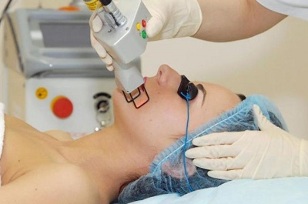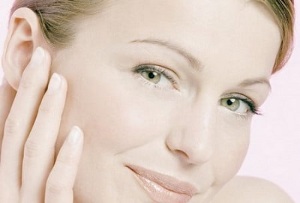In youth, facial skin looks smooth, fresh and toned, despite health and lack of cosmetic care. Over the years, its appearance gradually changes: first the pleasant color disappears and the first wrinkles appear, then cobwebs, age spots and deep wrinkles. Every change suggests that the skin is aging. When conventional face masks stop working, more powerful treatments come to the rescue, one of which is laser facial rejuvenation.
The advantage of fractional photothermolysis (this is its second name) is complete safety and high efficiency in eliminating wrinkles and other defects. This procedure is a gentler alternative to surgery or injection
Laser technology for skin rejuvenation
What causes skin aging? There are several main reasons:
- weakening of metabolic processes;
- delayed or incomplete disposal;
- impairment of cell growth function;
- Reduction of nutrient transfer to cells.

Of course, it is impossible to start the reverse process of cell regeneration, but there is a chance to activate the activity of "sleeping" cells. Laser facial rejuvenation is used for this. After heat treatment, the viable cells are activated and the weak ones die completely, giving way to stronger specimens. In short, the cellular composition of the skin is renewed.
The quality and speed of the recovery process depends on the diameter of the laser beam. Its thickness must be less than 200 microns. Fractional thermolysis has improved the effect of laser treatment: instead of a single beam, many microscopic beams act on the surface of the skin as if forming a network. Local areas are innovations in the application of laser technology. They help not to touch healthy areas of the skin, thus contributing to early recovery.
Types of fractional laser rejuvenation
Rejuvenation and lifting are performed using two effective exposure methods, which differ in some characteristics of laser use.
- Treatment of the entire skin surface
Its main function is to evaporate the upper cells of the epidermis. The superficial, visible microscopic areas are removed, which leads to a lifting effect - the skin looks tight. As a result, the first sign of aging disappears - a network of fine wrinkles.
- Exposure method without injuring the skin surface
Acts on the deeper, lower layers of the dermis and epidermis without affecting the uppermost area. Thus, it is recommended to solve deeply affected problems concerning the irreversible process of skin aging. With the help of a laser beam, a new membrane skeleton of the cell is built, the metabolic process is activated, collagen production is improved, as a result, the skin looks younger from the inside.

Both methods are aimed at local treatment, ie the areas of the skin around are not affected - this is necessary for rapid and complete recovery of the skin. In fact, fractional laser facial rejuvenation can be called heat shock, which resumes the growth of healthy cells.
The combination of the two methods allows you to get maximum results thanks to the double healing impulse outside and inside. This technique is practiced in many modern clinics with laser equipment.
Procedure progress and results
The advantage of laser skin treatment is painlessness, which is an attractive factor for people with a high fear of pain. The procedure itself is divided into several stages.
- Superficial anesthesia, after which the patient does not feel pain, but only feels a slight tingling sensation in the treatment area. The anesthetic composition is administered immediately before the session
- Conducting a session with the help of a special device, the operation of which is based on the use of a fractional laser. The duration of the session is within an hour, although the exact time depends on the number of treated areas.
- Apply revitalizing cream on the skin.
- Consultation with a skin care specialist
It will take about a week for the skin to get an updated look. This is a fairly short period compared to, for example, surgery
For the first two days, the swelling will remain on the face, then it will change to redness, after which the skin will begin to peel off - the process of releasing dead cells begins. They will be replaced by healthy, young cells that will give the face a fresh, youthful look.
Indications for fractional photothermolysis
Most women, and some men are no exception, take good care of themselves, so not only fractional facial rejuvenation but also laser photothermolysis of other parts of the body has become popular.
Most often patients turn if they need:
- restores the skin of the whole body or some of its areas, especially visible;
- removal of capillary networks and pigmentation;
- pore reduction;
- removal of scars, stretch marks, scars;
- skin whitening;
- smoothing or removing wrinkles on the face;
- rejuvenation of the skin of the hands, chest, neck;
- update skin texture, lift.
Contraindications for procedure
Each salon procedure has general and specific contraindications, laser treatment of facial skin is no exception.
So procedures using a fractional laser are prohibited for patients with any of the following diagnoses:
- deficiency of immunity, as a result - frequent infectious diseases;
- pregnancy, lactation;
- dermatosis in the field of treatment;
- marks;
- cancer;
- chronic blood diseases, diabetes mellitus;
- herpes

In addition, laser rejuvenation should be delayed if you are taking retinoids six months before the session and if you have a fresh complexion.
Every woman, regardless of age, wants to have attractive, healthy skin
There are a number of diseases in which the procedure is possible, but only after consultation with a specialist, therefore before the session it is necessary to consult your doctor. If, however, one or more contraindications are found, it is recommended that you endure a certain period until complete recovery or the onset of a condition when the body is ready for the laser. The procedure itself is safe, but if there is a disease, it can provoke its further development.
If you cannot use a laser, you should choose other methods to get rid of the signs of skin aging, such as injections of Botox or hyaluronic acid.













































































